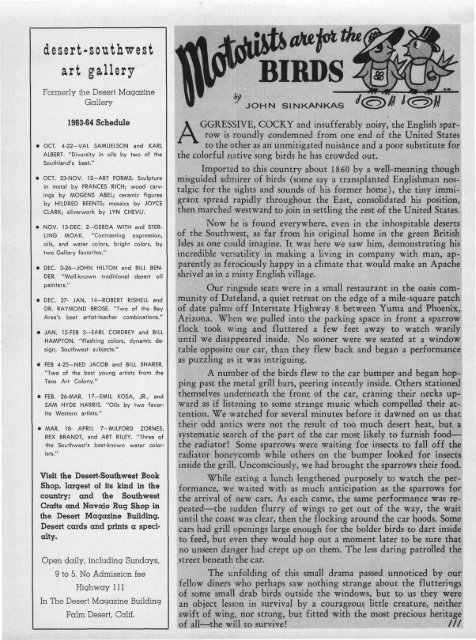randall henderson petroglyphs - Desert Magazine of the Southwest
randall henderson petroglyphs - Desert Magazine of the Southwest
randall henderson petroglyphs - Desert Magazine of the Southwest
You also want an ePaper? Increase the reach of your titles
YUMPU automatically turns print PDFs into web optimized ePapers that Google loves.
desert-southwest<br />
art gallery<br />
Formerly <strong>the</strong> <strong>Desert</strong> <strong>Magazine</strong><br />
Gallery<br />
1963-64 Schedule<br />
• OCT. 4-22-VAL SAMUELSON and KARL<br />
ALBERT. "Diversity in oils by two <strong>of</strong> <strong>the</strong><br />
Southland's best."<br />
• OCT. 23-NOV. 12-ART FORMS: Sculpture<br />
in metal by FRANCES RICH; wood carvings<br />
by MOGENS ABEL; ceramic figures<br />
by HILDRED REENTS; mosaics by JOYCE<br />
CLARK; silverwork by LYN CHEVLI.<br />
• NOV. 13-DEC. 2—GERDA WITH and STER-<br />
LING MOAK. "Contrasting expression,<br />
oils, and water colors, bright colors, by<br />
two Gallery favorites."<br />
• DEC. 3-26—JOHN HILTON and BILL BEN-<br />
DER. "Well-known traditional desert oil<br />
painters."<br />
• DEC. 27- JAN. 14-ROBERT RISHELL and<br />
DR. RAYMOND BROSE. "Two <strong>of</strong> <strong>the</strong> Bay<br />
Area's best artist-teacher combinations."<br />
• JAN. 15-FEB 3-EARL CORDREY and BILL<br />
HAMPTON. "Flashing colors, dynamic de-<br />
sign, <strong>Southwest</strong> subjects."<br />
• FEB 4-25-NED JACOB and BILL SHARER.<br />
"Two <strong>of</strong> <strong>the</strong> best young artists from <strong>the</strong><br />
Taos Art Colony."<br />
• FEB. 26-MAR. 17-EMIL KOSA, JR., and<br />
SAM HYDE HARRIS. "Oils by two favorite<br />
Western artists."<br />
• MAR. 18- APRIL 7-MILFORD ZORNES,<br />
REX BRANDT, and ART RILEY. "Three <strong>of</strong><br />
<strong>the</strong> <strong>Southwest</strong>'s best-known water colorists."<br />
Visit <strong>the</strong> <strong>Desert</strong>-<strong>Southwest</strong> Book<br />
Shop, largest <strong>of</strong> its kind in <strong>the</strong><br />
country; and <strong>the</strong> <strong>Southwest</strong><br />
Crafts and Navajo Rug Shop in<br />
<strong>the</strong> <strong>Desert</strong> <strong>Magazine</strong> Building.<br />
<strong>Desert</strong> cards and prints a specialty.<br />
Open daily, including Sundays,<br />
9 to 5. No Admission fee<br />
Highway 111<br />
In The <strong>Desert</strong> <strong>Magazine</strong> Building<br />
Palm <strong>Desert</strong>, Calif.<br />
BIRDS<br />
JOHN SINKANKAS<br />
AGGRESSIVE, COCKY and insufferably noisy, <strong>the</strong> English sparrow<br />
is roundly condemned from one end <strong>of</strong> <strong>the</strong> United States<br />
to <strong>the</strong> o<strong>the</strong>r as an unmitigated nuisance and a poor substitute for<br />
<strong>the</strong> colorful native song birds he has crowded out.<br />
Imported to this country about 1860 by a well-meaning though<br />
misguided admirer <strong>of</strong> birds (some say a transplanted Englishman nostalgic<br />
for <strong>the</strong> sights and sounds <strong>of</strong> his former home), <strong>the</strong> tiny immigrant<br />
spread rapidly throughout <strong>the</strong> East, consolidated his position,<br />
<strong>the</strong>n marched westward to join in settling <strong>the</strong> rest <strong>of</strong> <strong>the</strong> United States.<br />
Now he is found everywhere, even in <strong>the</strong> inhospitable deserts<br />
<strong>of</strong> <strong>the</strong> <strong>Southwest</strong>, as far from his original home in <strong>the</strong> green British<br />
Isles as one could imagine. It was here we saw him, demonstrating his<br />
incredible versatility in making a living in company with man, apparently<br />
as ferociously happy in a climate that would make an Apache<br />
shrivel as in a misty English village.<br />
Our ringside seats were in a small restaurant in <strong>the</strong> oasis community<br />
<strong>of</strong> Dateland, a quiet retreat on <strong>the</strong> edge <strong>of</strong> a mile-square patch<br />
<strong>of</strong> date palms <strong>of</strong>f Interstate Highway 8 between Yuma and Phoenix,<br />
Arizona. When we pulled into <strong>the</strong> parking space in front a sparrow<br />
flock took wing and fluttered a few feet away to watch warily<br />
until we disappeared inside. No sooner were we seated at a window<br />
table opposite our car, than <strong>the</strong>y flew back and began a performance<br />
as puzzling as it was intriguing.<br />
A number <strong>of</strong> <strong>the</strong> birds flew to <strong>the</strong> car bumper and began hopping<br />
past <strong>the</strong> metal grill bars, peering intently inside. O<strong>the</strong>rs stationed<br />
<strong>the</strong>mselves underneath <strong>the</strong> front <strong>of</strong> <strong>the</strong> car, craning <strong>the</strong>ir necks upward<br />
as if listening to some strange music which compelled <strong>the</strong>ir attention.<br />
We watched for several minutes before it dawned on us that<br />
<strong>the</strong>ir odd antics were not <strong>the</strong> result <strong>of</strong> too much desert heat, but a<br />
systematic search <strong>of</strong> <strong>the</strong> part <strong>of</strong> <strong>the</strong> car most likely to furnish food—<br />
<strong>the</strong> radiator! Some sparrows were waiting for insects to fall <strong>of</strong>f <strong>the</strong><br />
radiator honeycomb while o<strong>the</strong>rs on <strong>the</strong> bumper looked for insects<br />
inside <strong>the</strong> grill. Unconsciously, we had brought <strong>the</strong> sparrows <strong>the</strong>ir food.<br />
While eating a lunch leng<strong>the</strong>ned purposely to watch <strong>the</strong> performance,<br />
we waited with as much anticipation as <strong>the</strong> sparrows for<br />
<strong>the</strong> arrival <strong>of</strong> new cars. As each came, <strong>the</strong> same performance was repeated—<strong>the</strong><br />
sudden flurry <strong>of</strong> wings to get out <strong>of</strong> <strong>the</strong> way, <strong>the</strong> wait<br />
until <strong>the</strong> coast was clear, <strong>the</strong>n <strong>the</strong> flocking around <strong>the</strong> car hoods. Some<br />
cars had grill openings large enough for <strong>the</strong> bolder birds to dart inside<br />
to feed, but even <strong>the</strong>y would hop out a moment later to be sure that<br />
no unseen danger had crept up on <strong>the</strong>m. The less daring patrolled <strong>the</strong><br />
street beneath <strong>the</strong> car.<br />
The unfolding <strong>of</strong> this small drama passed unnoticed by our<br />
fellow diners who perhaps saw nothing strange about <strong>the</strong> flutterings<br />
<strong>of</strong> some small drab birds outside <strong>the</strong> windows, but to us <strong>the</strong>y were<br />
an object lesson in survival by a courageous little creature, nei<strong>the</strong>r<br />
swift <strong>of</strong> wing, nor strong, but fitted with <strong>the</strong> most precious heritage<br />
<strong>of</strong> all—<strong>the</strong> will to survive! ///

















